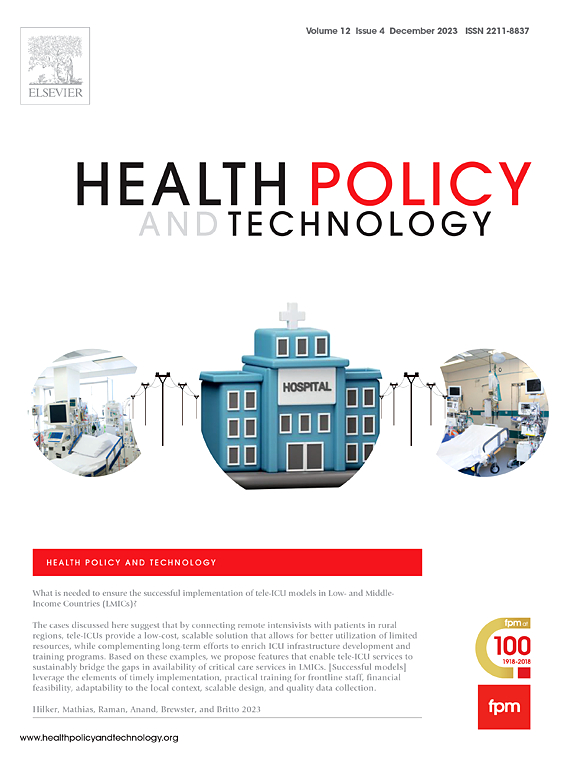Association of demographic characteristics of COVID-19 patients with RPA Virtual Hospital service utilization in 2020-22
IF 3.7
3区 医学
Q1 HEALTH POLICY & SERVICES
引用次数: 0
Abstract
Objectives
The rapid adoption of telemedicine during the COVID-19 pandemic has transformed healthcare delivery. In Australia, RPA Virtual Hospital (rpavirtual) has emerged as a key healthcare provider in telehealth. However, the uptake of virtual care among non-English-speaking patients remains understudied. This study aimed to profile COVID-19 patients cared for by rpavirtual and examine the association between patients’ demographics and service utilization.
Method
A retrospective study was conducted using routinely collected electronic medical records. Participants were 21,814 COVID-19 patients, registered with rpavirtual between July 1, 2020, and June 30, 2022, in Sydney Local Health District, NSW. Multiple logistic regression models were built to examine the association between service utilization and preferred language and other demographics. Subgroup analyses were conducted by patients’ age group and preferred language.
Results
Compared to English-speaking patients, non-English-speaking patients were less likely to register with rpavirtual ≥ 2 times (adjusted odds ratio (AOR) 0.86, 95 % CI 0.77 – 0.96), receive ≥ 3 services (AOR 0.92, 95 % CI 0.85 – 1.00), and have service duration ≥76 min (AOR 0.92, 95 % CI 0.85 – 0.99). Among patients aged 50 years or older, these associations were particularly pronounced, with AOR 0.77 (95 % CI 0.66 – 0.89), AOR 0.86 (95 % CI 0.78 – 0.96), and AOR 0.86 (95 % CI 0.78 – 0.95) for number of registrations and services and total service duration, respectively. Among non-English-speaking patients, interpreter use was strongly associated with increased service utilization.
Conclusion
Preferred language shapes virtual care utilization patterns. Providing language support improves equitable access and engagement in virtual care platforms.
Lay summary
There was a significant pivot towards virtual care during the COVID-19 pandemic. In Australia, RPA Virtual Hospital (rpavirtual) has emerged as a key healthcare provider in telehealth. This study analyzed routinely collected electronic medical records of 21,814 COVID-19 patients, registered with rpavirtual between July 1, 2020, and June 30, 2022, in Sydney Local Health District, NSW. The study found that COVID-19 patients’ demographics were associated with rpavirtual utilization, and interpreter use was strongly associated with increased service utilization. There were significant disparities in utilization between non-English-speaking and English-speaking patients. Non-English-speaking patients were less likely to register with rpavirtual multiple times, receive more services, and have longer service duration. The associations of preferred language with service utilization were particularly pronounced among patients aged 50 years or older. The results suggest that preferred language shapes virtual care utilization. Language support is key to improving accessibility and engagement in virtual care.
2020- 2022年COVID-19患者人口学特征与RPA虚拟医院服务利用的关系
在2019冠状病毒病大流行期间,远程医疗的迅速普及改变了医疗保健服务。在澳大利亚,RPA虚拟医院(rpavirual)已成为远程医疗的关键医疗保健提供者。然而,非英语患者对虚拟护理的接受程度仍未得到充分研究。本研究旨在分析由虚拟医院护理的COVID-19患者,并检查患者人口统计数据与服务利用率之间的关系。方法采用常规收集的电子病历资料进行回顾性研究。参与者是2020年7月1日至2022年6月30日在新南威尔士州悉尼地方卫生区注册的21814名COVID-19患者。建立了多个逻辑回归模型来检验服务利用率与首选语言和其他人口统计学之间的关系。按患者年龄和首选语言进行亚组分析。结果与英语患者相比,非英语患者登记≥2次(调整优势比(AOR) 0.86, 95% CI 0.77 ~ 0.96),接受≥3次服务(AOR 0.92, 95% CI 0.85 ~ 1.00),服务时间≥76 min (AOR 0.92, 95% CI 0.85 ~ 0.99)的可能性较小。在50岁及以上的患者中,这些关联尤为明显,分别为AOR 0.77 (95% CI 0.66 - 0.89)、AOR 0.86 (95% CI 0.78 - 0.96)和AOR 0.86 (95% CI 0.78 - 0.95)。在非英语患者中,口译员的使用与服务利用率的增加密切相关。结论首选语言塑造了虚拟护理使用模式。提供语言支持可改善虚拟护理平台的公平获取和参与。在2019冠状病毒病大流行期间,出现了向虚拟医疗的重大转变。在澳大利亚,RPA虚拟医院(rpavirual)已成为远程医疗的关键医疗保健提供者。本研究分析了2020年7月1日至2022年6月30日期间在新南威尔士州悉尼地方卫生区注册的21814名COVID-19患者的常规电子病历。研究发现,COVID-19患者的人口统计数据与虚拟服务的利用率有关,口译员的使用与服务利用率的提高密切相关。非英语患者和英语患者在用药方面存在显著差异。非英语患者不太可能多次登记,接受更多的服务,服务时间更长。在50岁或以上的患者中,首选语言与服务利用的关联尤为明显。结果表明,首选语言影响虚拟护理的利用。语言支持是提高虚拟护理可及性和参与度的关键。
本文章由计算机程序翻译,如有差异,请以英文原文为准。
求助全文
约1分钟内获得全文
求助全文
来源期刊

Health Policy and Technology
Medicine-Health Policy
CiteScore
9.20
自引率
3.30%
发文量
78
审稿时长
88 days
期刊介绍:
Health Policy and Technology (HPT), is the official journal of the Fellowship of Postgraduate Medicine (FPM), a cross-disciplinary journal, which focuses on past, present and future health policy and the role of technology in clinical and non-clinical national and international health environments.
HPT provides a further excellent way for the FPM to continue to make important national and international contributions to development of policy and practice within medicine and related disciplines. The aim of HPT is to publish relevant, timely and accessible articles and commentaries to support policy-makers, health professionals, health technology providers, patient groups and academia interested in health policy and technology.
Topics covered by HPT will include:
- Health technology, including drug discovery, diagnostics, medicines, devices, therapeutic delivery and eHealth systems
- Cross-national comparisons on health policy using evidence-based approaches
- National studies on health policy to determine the outcomes of technology-driven initiatives
- Cross-border eHealth including health tourism
- The digital divide in mobility, access and affordability of healthcare
- Health technology assessment (HTA) methods and tools for evaluating the effectiveness of clinical and non-clinical health technologies
- Health and eHealth indicators and benchmarks (measure/metrics) for understanding the adoption and diffusion of health technologies
- Health and eHealth models and frameworks to support policy-makers and other stakeholders in decision-making
- Stakeholder engagement with health technologies (clinical and patient/citizen buy-in)
- Regulation and health economics
 求助内容:
求助内容: 应助结果提醒方式:
应助结果提醒方式:


